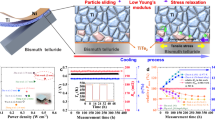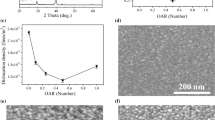Abstract
Integration of thermoelectric devices within an automotive heat exchanger could enable conversion of lost heat into electrical energy, contributing to improved total output from the engine. For this purpose, synthesis of thick bismuth telluride (Bi2Te3) films is required. Bismuth telluride has been produced by an electrochemical method in nitric acid with a sacrificial bismuth telluride anode as the source of cations. The binary layer grows on the working electrode while the counter-electrode, a Bi2Te3 disk obtained by high frequency melting, is oxidized to BiIII and TeIV. This process leads to auto-regeneration of the solution without modification of its composition. The thickness of films deposited by use of the Bi2Te3 anode was approximately 10 times that without. To demonstrate the utility of a soluble anode in electrochemical deposition, we report characterization of the composition and morphology of the films obtained under different experimental conditions. Perfectly dense and regular Bi2Te3 films (∼400 μm) with low internal stress and uniform composition across the cross-section were prepared. Their thermoelectric properties were assessed.
Similar content being viewed by others
References
F. Xiao, C. Hangarter, B. Yoo, Y. Rheem, K.H. Lee, and N.V. Myung, Electrochim. Acta 53, 8103 (2008).
C. Boulanger, J. Electron. Mater. 39, 1818 (2010).
A. Zimmer, N. Stein, H. Terryn, and C. Boulanger, J. Phys. Chem. Solids 68, 1902 (2007).
S. Michel, S. Diliberto, C. Boulanger, N. Stein, and J.M. Lecuire, J. Cryst. Growth 277, 274 (2005).
S. Michel, S. Diliberto, N. Stein, B. Bolle, and C. Boulanger, J. Solid State Electrochem. 12, 95 (2008).
M. Martin-Gonzalez, A.L. Prieto, R. Gronsky, T. Sands, and A.M. Stacy, J. Electrochem. Soc. 149, C546 (2002).
W. Glatz, L. Durrer, E. Schwyter, and C. Hierold, Electrochim. Acta 54, 755 (2008).
S. Li, M.S. Toprak, H.M.A. Soliman, J. Zhou, M. Muhammed, D. Platzek, and E. Müller, Chem. Mater. 18, 3627 (2006).
H.P. Nguyen, M. Wu, J. Su, R.J.M. Vullers, P.M. Vereecken, and J. Fransaer, Electrochim. Acta 68, 9 (2012).
W.J. Li, Electrochim. Acta 54, 7167 (2009).
Li FH and W. Wang, Electrochim. Acta 55, 5000 (2010).
H.P. Nguyen, J. Su, Z. Wang, R.J.M. Vullers, P.M. Vereecken, and J. Fransaer, ECS Trans. 33, 75 (2011).
J. Zhou, S. Li, M.A. Soliman, M.S. Toprak, M. Muhammed, D. Platzek, and E. Müller, Phys. Status Solidi (c) 5, 3453 (2008).
F. Golgovici, A. Cojocaru, M. Nedelcu, and T. Visan, J.␣Electron. Mater. 38, 2079 (2010).
F. Golgovici, A. Cojocaru, L. Anicai, and T. Visan, Mater. Chem. Phys. 126, 700 (2011).
H. Ebe, M. Ueda, and T. Ohtsuka, Electrochim. Acta 53, 100 (2007).
W. Glatz, S. Muntwyler, and C. Hierold, Sens. Actuators A Phys. 132, 337 (2006).
M.Y. Kim, T.S. Oh, and J.S. Kim, J. Korean Phys. Soc. 50, 670 (2007).
Acknowledgement
We acknowledge financial support from the French Environment and Energy Management Agency (ADEME).
Author information
Authors and Affiliations
Corresponding author
Rights and permissions
About this article
Cite this article
Maas, M., Diliberto, S., de Vaulx, C. et al. Use of a Soluble Anode in Electrodeposition of Thick Bismuth Telluride Layers. J. Electron. Mater. 43, 3857–3862 (2014). https://doi.org/10.1007/s11664-014-3292-1
Received:
Accepted:
Published:
Issue Date:
DOI: https://doi.org/10.1007/s11664-014-3292-1




